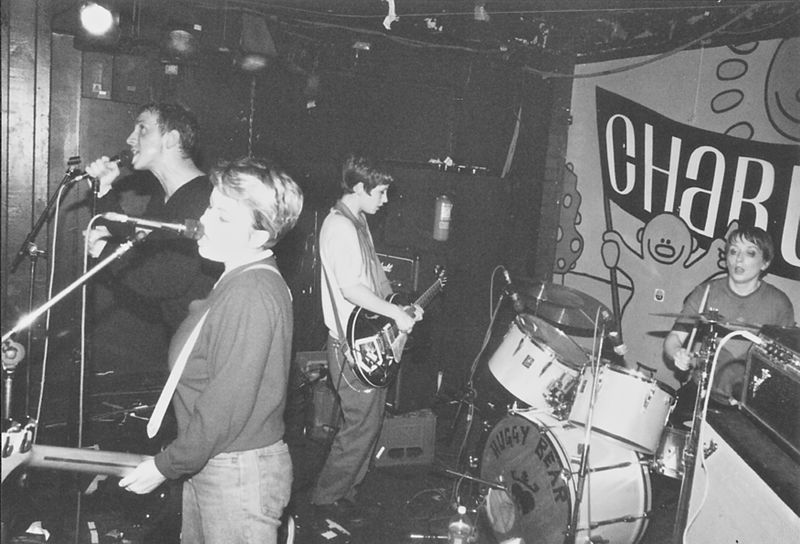Riot Grrrl was the movement I always wish I’d got to experience first hand. It was a huge movement in the ’90s and although there are many versions of how the movement started, most people would agree that the band attributed with starting up Riot Grrrl was Bikini Kill. Starting out with a free zine with the same name, they later became a band and were into creating more female-focussed gigs by encouraging the boys who wanted to mosh and dance violently to head to the back, while the girls could enjoy the music at the front if they wanted. As with any feminist movement, they were labelled sexist towards men, but that wasn’t what it was about – it was about trying to do something that women could enjoy just as much as men.
The zines carried on from the punk ethos of the ’70s and the college idea of freedom of speech. Cutting and pasting together pieces of photos and literature was the original form of what we now have in many online zines – but before the internet was really used, it was important to have something that could be reproduced, photocopied and passed around to get the message out. It was never about making money but about spreading the word, and helping girls to come together. And also, importantly, about advertising girl punk rock bands, which were hardly seen in major music magazines – and if they were, were normally insulted or at best, classed as “good for girls.”
“We want and need to encourage and be encouraged in the face of all our own insecurities, in the face of beergutboyrock that tells us we can’t play our instruments, in the face of “authorities” who say our bands/zines/etc are the worst in the US” The Riot Grrrl Manifesto
The bands grouped together, and there seemed to be much less of the competition between bands than often happens now, because they were all fighting for the same cause. They wanted to talk about the issues that women go through but were never allowed to talk about; like childhood abuse, rape, abortions and equal pay issues. They could talk about lesbianism, but in a way that wasn’t designed to just attract men – real love between two women, which was either unspoken or still considered “just a phase.”
Riot Grrrl has taken on many forms, and although it is largely associated with punk rock music, anyone who believes in the Riot Grrrl manifesto could be one, whether they realise it or not. Singers like Beth Ditto have come out as saying they support the movement – Ditto said that Riot Grrrl helped her to become a whole person. Other contemporay artists and bands which seem to fit into the movement include Amanda Palmer, PJ Harvey, Regina Spektor and the Yeah Yeah Yeahs. Not many people would come out as saying they’re Riot Grrrl – any more than people tend to announce that they’re feminist. It’s not about declaring it as a publicity stunt, it’s about being it and getting across the ideas in your music.
Seeing girls in the rock business doesn’t happen all that often, even now – of course they exist, but usually as lead singers or bassists. These are seen as the “acceptable” places for women to have power, but the drums and electric guitars – the instruments that are seen to be gritty and difficult – are reserved for the men. The movement also revolutionised the idea of a female musician who didn’t have to be beautiful or thin, just talented. Even now in the rock industry there are so few female musicians who are not conventionally attractive, when in history male singers such as Steve Tyler, Axl Rose and Sting were seen as sex icons despite not being commonly accepted as attractive. In many metal bands, the attractiveness of a male lead singer means nothing, but Christina Scabbia of Lacuna Coil will be criticised if she puts on a little weight or takes an unflattering photo.
“You learn that the only way to get rock-star power as a girl is to be a groupie and bare your breasts and get chosen for the night. We learn that the only way to get anywhere is through men. And it’s a lie.” Kathleen Hanna, Bikini Kill
I think one of the greatest parts of the movement was the girls’ acceptance of what people thought of them – they said “I know you think I’m a bitch, so I’m going to write it on my arm,” and often wrote conflicting messages on their arms, such as the famous picture of the band Huggy Bear in which lead singer Niki Elliot has written “Slut” on one arm, and “Prophet” on the other. Other than that, there was no distinctive style for Riot Grrrl – no way to dress like one – which meant it couldn’t be corrupted by capitalism as easily as, say, Punk culture.
Riot Grrrl brought feminism into the public eye in a way that was less academic and less structured – instead of only finding a voice in studying feminism as a subject, or by participating in marches, girls were able to kick and scream about what really mattered to them. It gave girls – normal girls – a voice, and that voice wasn’t what a lot of people wanted to hear.
A re-emergence seems to be happening now – the DIY ethic that Riot Grrrl helped bring back with third-wave feminism has stuck longer than anyone had predicted, and with films like Whip It!, we get to see natural women a little easier than before. So for all of those who thought that Riot Grrrl was just a phase, just some angry girls kicking off – you were very much mistaken.
Posted both in Snippets #19 and on Neutral 2013
